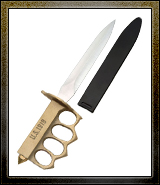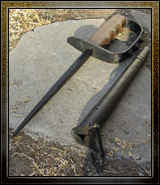
Introduction
The Trench Knife was first developed for close-quarters fighting in the trenches of World War I. There are many different models and styles of the trench knife. This review focuses primarily on the models with the "knuckle duster" or "brass knuckle" style hand guard. The first issued model (US Model 1917) featured a triangular blade similar to that of a bayonet, with a wooden handle and attached metal hand guard. It was replaced soon after by the "US Model 1918" or "Mark 1".
Functionality [10/10]
|
 |
|
The Model 1918 Mark 1
"Trench Knife"
|
The materials used to make most replica trench knives or "brass knuckle knives" are usually not as durable as the materials for the original military version. This limits the knife's uses and lifespan although it can still be used for tasks other than scrambling brains. Unfortunately, tasks like digging, prying, and cutting may damage the knife over time or break the blade away from the grip quicker than one might imagine. Due to its fairly soft blade, it will require much more sharpening than some harder knives.
Effectiveness [7/10]
The Trench Knife is an extremely effective close-quarters weapon for battle against the undead. With the correct amount of force the Trench Knife can be driven into the skull to deliver the finishing blow to any zombie. It also has the advantage of the hand guard that doubles as a "knuckle duster" or brass knuckle. If need be, you can easily deliver quick blows to momentarily knock back your enemy while keeping your hand from directly contacting the zombie to avoid accidental infection. The Mark 1 Trench Knife also features a pointed pommel called the skull crusher point which may not be terribly effective when fighting a zombie.
Durability [6/10]
Most replicas of the 1918 Trench Knife are made from 420-J2 stainless steel, with a brass handle. 420-J2 is a fairly soft steel that will not hold an edge during hard use, though it has a very high corrosion resistance and requires little care. However, 420-J2 is not as durable as 1095 carbon steel, which corrodes and requires cleaning, but will last much longer, and is what knives like the Ka-Bar Combat Knife are made from. Most trench knife blades are secured to the handle by a pommel, while some newer designs are push tangs (meaning, the blade is pushed into a preformed handle and secured in place). This isn't quite as good as a full tang since there is a chance that in heavy use the blade can break away or detach from the grip.
Portability [10/10]
|
 |
|
The larger 1917 Trench Knife
|
There are many different trench knives varying in size from 15 inches (38.1 cm) to 9 inches (22.86 cm). The original trench knives were approximately 12 inches (22.86 cm) in length, with a 6.5 inch (16.51 cm) blade. Almost every trench knife has its own sheath or scabbard and can easily be attached to a belt, vest or boot. Some of the newer "brass knuckle knives" come with shoulder straps and quick-release sheaths, which can be very useful to keep the knife out of the way while on the move.
Practicality [8/10]
The Trench Knife is one of the best hand to hand combat weapons available. It's easy to carry and you don't need to worry about cleaning because most are made from stainless steel. Still, unless you get one made of a more durable material, you will find that it needs to be sharpened frequently and is limited in its uses.
|